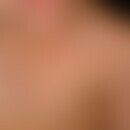Synonym(s)
HistoryThis section has been translated automatically.
Tilbury Fox, 1873
DefinitionThis section has been translated automatically.
Disease of varying etiology associated with clear intraepidermal vesicles on palms and soles, often accompanied by hyperhidrosis. Here, the skin appears shagreen-like, white or reddish, as if filled with cooked sago granules. The clinically visible vesicles are an expression of an underlying spongiotic dermatitis in the area of the inguinal skin. See also Dermatitis dyshidrotic.
You might also be interested in
EtiopathogenesisThis section has been translated automatically.
Polyetiological clinical picture often associated with Hyperhidrosis manuum (pedum). The increased occurrence in summer and an increased prevalence in warm and humid climates underlines the relationship to an increased sweat gland function.
Idiopathic: often a cause cannot be identified!
Dyshidrosis as Id reaction: can occur as a mycid in acute exacerbation of a tinea pedis or corporis.
Contact allergy: often occurs at the base of dyshidrosis. In the case of contact allergy caused by insoles, this is the only trigger of dyshidrosis.
Minimal variant of atopic dermatitis, possibly also in the context of an acute episode of psoriasis palmaris et plantaris.
LocalizationThis section has been translated automatically.
ClinicThis section has been translated automatically.
Clear, intraepidermally located, small, coarse, 0.1cm to 0.2-0.3cm in size, but sometimes markedly larger, variably pruritic, occasionally painful vesicles. Drying up and formation of a ruff-like scaling or bursting and formation of erosions. If pricked, a stringy, clear, sometimes cloudy fluid emerges. The vesicles of dyshidrosis have no tendency to open spontaneously. Rather, they dry up within a few days, leaving only circine desquamation as a residual. Underneath, a smooth, reddish non-weeping surface becomes visible. An episode lasts 5-20 days.
Often vesicles are not noticed (larvated dyshidrosis) or they do not appear clinically, so that the clinical picture only appears as a recurrent scaling scenario, with a dry ruff-like scaling(dyshidrosis lamellosa sicca).
A maximum variant of dyshidrosis or dyshidrotic dermatitis with large blisters is called pompholyx(cheiropompholyx=infestation of the palms or podopompholyx=infestation of the soles).
HistologyThis section has been translated automatically.
DiagnosisThis section has been translated automatically.
Differential diagnosisThis section has been translated automatically.
Pustulosis palmaris et plantaris: primary pustule formation, not limited to palma/planta.
Miliaria cristallina: intracorneal vesicle formation that may occur on the trunk and extremities in severely transpiring febrile patients.
General therapyThis section has been translated automatically.
External therapyThis section has been translated automatically.
For initial changes and as a prophylactic measure, local baths with astringent additives such as synthetic tanning agents (e.g., Tannolact, Tannosynt). In the case of non-infectious genesis (e.g. atopic eczema, allergic contact eczema) in the acute stage, glucocorticoid tinctures such as 0.1% triamcinolone acetonide tincture(e.g. Triamgalen Lsg. or 0.1% mometasone solution (e.g. Ecural®) and compresses with tanning additives such as oak bark extract or synthetic tanning agents (e.g. Tannosynt, Tannolact). If necessary, after the acute phase has subsided, zinc oxide paste with bismuth gallate(Zinc oxide paste 50% with bismuth gallate 10% (NRF 11.112.) alternating with the tanning baths. In subacute stages and especially in the presence of hyperhidrosis, tap water iontophoresis can be tried. If collerette-like scaling is present, glucocorticoids in cream base such as 0.1% triamcinolone acetonide cream(e.g., Delphicort; triamcinolone acetonide cream hydrophilic 0.025/0.05/0.1% (NRF 11.38.) or 0.25% prednicarbate cream(e.g., Dermatop®) may be applied, with occlusion if necessary.
Internal therapyThis section has been translated automatically.
Note(s)This section has been translated automatically.
Dyshidrosis is a historical and unfortunately misunderstood term that describes acute or subacute dermatitis of the hands and feet. The term "dyshidrotic" refers to a "manifestation of eczema" which is caused by the special anatomical nature of the skin on the palms of the hands and soles of the feet (so-called groin skin). The groin skin is characterized by the absence of hair follicles and the formation of a protective, thick horny layer. In a blistering eczema reaction, the spongiotic blisters remain much longer in the skin and are perceived as fine grey dots in the horny layer, barely 0.1 cm in size. The term"dyshidrosis" is aimed at a defective sweat gland function, which in fact was not originally present. The term "dyshidrosiform", which is supposed to describe the formation of blisters in atopic hand and foot eczema, is equally misleading and superfluous.
LiteratureThis section has been translated automatically.
- Man I et al (2004) Photoinduced pompholyx: A report of 5 cases. J Am Acad Dermatol 50: 55-60
- Fox T (1873) Skin diseases. 3rd ed. H. Renshaw, London, p. 476
Incoming links (15)
Atopy; Atopy; Bubbles; Cheiropodopompholyx; Cheiropompholyx; Dyshidrosis; Dyshidrosis; Dyshidrosis syndrome; Dyshidrotic dermatitis; Podopompholyx; ... Show allOutgoing links (26)
Atopic dermatitis (overview); Atopic diathesis; Cefadroxil; Cefalexin; Cephalosporins; Cheiropompholyx; Contact dermatitis allergic; Cristalline miliaria; Dyshidrosis; Dyshidrosis lamellosa sicca; ... Show allDisclaimer
Please ask your physician for a reliable diagnosis. This website is only meant as a reference.








